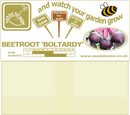Description
Boltardy is one of our favourite and most reliable beetroot varieties with smooth skin, evenly shaped globe roots and deep ruby red sweet flesh. It is often exhibited and grows really well in pots.
As the name suggests it has excellent resistance to bolting and means that it can be sown as early as March (in a cold frame or cloche) in most areas. This is a popular variety to grow with children given the reliability and they will love the varied uses; such as baking it in cakes, or making beetroot ice cream and smoothies!
| When to sow | March to July (Early March in a cold frame or under cloches for an earlier crop and sown in July to produce baby beet in the autumn) |
| Where to Sow | Sow thinly in shallow drills 2cm (3/4") deep with 30cm (12") between rows. It is best to sow beetroot seeds directly into the ground (or container) when the temperature of the soil has warmed to about 7°C (44°F). |
| What to do Next | Each 'seed' is actually a fruit composed of three or four seeds. Thin the seedlings gradually as they grow to an eventual spacing of 10cm (4"). If carefully removed, the seedlings can be transplanted to form additional rows. Once the roots have developed and they start to swell, beetroots need to be watered moderately. Beetroot has shallow roots and it is important to keep the plants moist. If they experience long dry periods, the beetroot will become hairy and fibrous. Intermittent or inadequate watering can result in stress cracks and breakdown of roots. Don't overwater as this only encourages leaf growth and not bulb growth. During cool weather, the plants can be watered once a week. During very hot weather, less water can be given two to three times a week instead of a lot of water once a week. |
| Harvest | June to October - To harvest lift carefully, twist off stems with your hands to prevent the plants bleeding their juice. |
| Handy Tips | The seeds require plenty of moisture to germinate. Soaking them in warm water for an hour or two prior to planting is a great way to speed up germination. Prevent a glut when planting beetroot by sowing your seed in stages, a small batch at a time every couple of weeks, will give a continuous harvest. If the soil is well drained ( or they are grown in a container) they be left in soil for winter in mild areas. Cover with a layer of straw for extra protection. |
| Companion Planting | Good Companions - Onions, Silver beet, Kohlrabi, Lettuce, Cabbage, Dwarf Beans. Aromatic Herbs, Celery, Chamomile, Spinach, Chard. Bad Companions - tall beans, runner beans. |
| Nutritional Information | Rich in beta carotene calcium , iron & folic acid. |
| Serving Suggestion | The deep-red roots can be eaten cooked (boiled, steamed or roasted as a vegetable), hot or cold, or grated raw in salads. Small beets are also excellent pickled. The young leaves are also edible and can be eaten raw in salads or cooked like spinach. |
Payment & Security
Your payment information is processed securely. We do not store credit card details nor have access to your credit card information.




